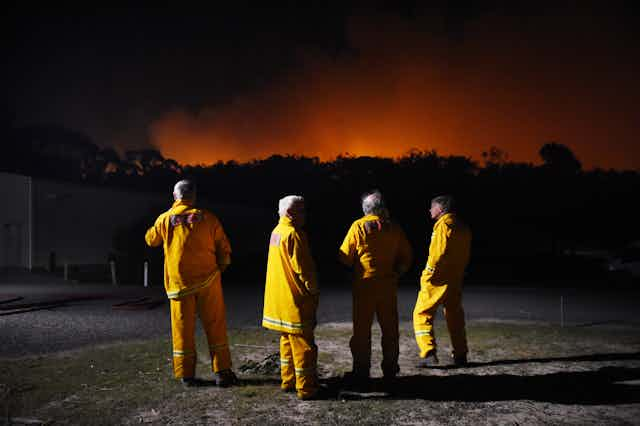Emergency services in Australia are struggling to hold onto their volunteer staff. In New South Wales, for example, only half of the 1,700 volunteers who join the State Emergency Service are still active members a year later. In Western Australia, the overall yearly turnover is 12-18% and rising.
This represents a serious drain on the sector. Precise volunteer numbers are not always collated, but we estimate that more than 240,000 emergency service volunteers across Australia help to protect regional, rural and remote communities where the sprawling areas make it impractical to rely solely on career emergency workers.
The large turnover is an economic liability, as training and uniforms (including personal protective equipment) are expensive. Meanwhile, the constant drain of volunteers can affect not just operational capacity, but morale too.
Volunteer brigades and units are managed by the volunteers themselves. This can lead to tensions between these quasi-independent groups and the paid staff who work in the regional, district of head office. But such tensions can also arise within the volunteer groups themselves, and effective leadership is therefore a crucial element in retaining new recruits.
Keeping volunteers on board
Our research group has therefore partnered with Australian emergency service agencies to try to give leaders the interpersonal skills required to support members and hold onto volunteer staff more effectively.
To do this, we trialled a training program based on self-determination theory (SDT). Our results suggest this could be a very useful tool.
Self-determination theory recognises three basic psychological needs required for motivated, happy staff:
autonomy: the need for volition, to make decisions and express one’s personal initiatives and ideas
competence: the need to feel effective and capable
relatedness: the need to feel accepted and part of the group
Self-determination theory’s basic psychological needs have been researched and applied across diverse social environments such as homes, workplaces, schools, sports teams, and health care. Research suggests that when workers’ needs for autonomy, competence and relatedness are met they are more motivated, engaged, satisfied, and less likely to be considering quitting.
To try to apply this approach to volunteer emergency services, we developed a nine-week program called Inspire Retain Engage (IRE), to teach leaders to interact with their members using SDT principles.
The program consisted of a one-day face-to-face training to learn about self-determination theory and leadership, where leaders worked together to identify key strategies to support each of the three basic psychological needs. For example, leaders could build relatedness by getting to know volunteers and their interests.
Participants then developed their own nine-week action plan that they implemented in their units and brigades with the support of an online mentor. This was followed by a final day of reflection, sharing successes and identifying best practice.
We piloted the IRE program in 2014 with volunteer leaders from the New South Wales State Emergency Service and the NSW Rural Fire Service. It was then further refined and tested in 2016 with volunteer leaders and staff of the Victoria State Emergency Service and the Queensland Fire and Emergency Services.

In total, we have trialled this approach with 72 members from four different volunteer-based emergency service agencies.
We evaluated the program’s impact by surveying IRE participants, volunteer members supervised by participants and other volunteer leaders not a part of the program, both before and after IRE.
The findings revealed that the self-determination theory principles – encouraging autonomy, competence and relatedness in their role – were linked with higher job satisfaction among volunteers, and a more widespread intention to continue volunteering with their current agency. Basic psychological needs accounted for 56% of the variance in volunteers’ job satisfaction and 49% of turnover intention.
Getting results
When emergency service leaders were surveyed about current volunteer leadership courses available respondents told us that such training is often hard to access, limited in scope, and does not focus on interpersonal skills.
The results of the evaluation showed the IRE program improved leaders’ managerial orientation. When compared to other leaders in the organisation, program participants adopted more motivational and less controlling managerial approaches nine weeks later. In addition, 46% of members reported a difference in their team leader’s interactions with them during the program.
Overall, the feedback was overwhelmingly positive. 100% of leaders agreed that self-determination theory was a valuable model for emergency service leadership, and 84% said they would recommend the program to other leaders in their organisation.
As of 2017, the IRE program is available to all emergency service agencies in Australia and we are satisfied with its benefit to volunteer leaders, staff and their agencies.
But of course, only time will tell whether this kind of thinking will improve retention of our valued volunteer emergency workers in the long term.

